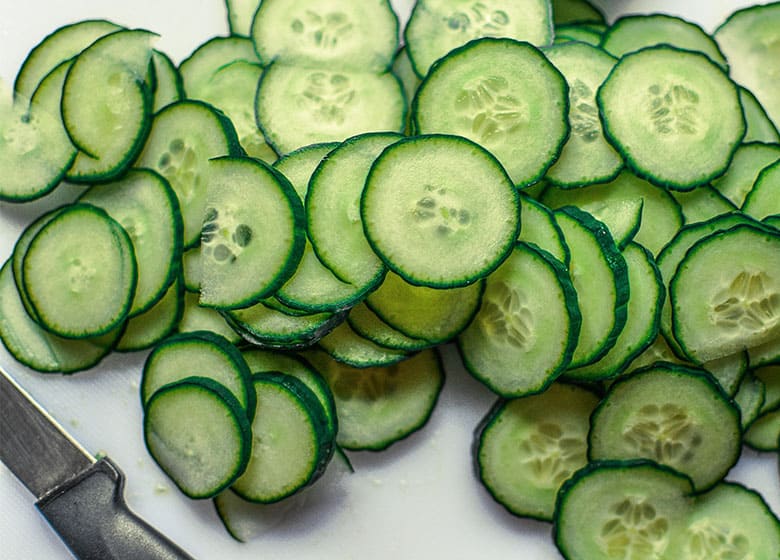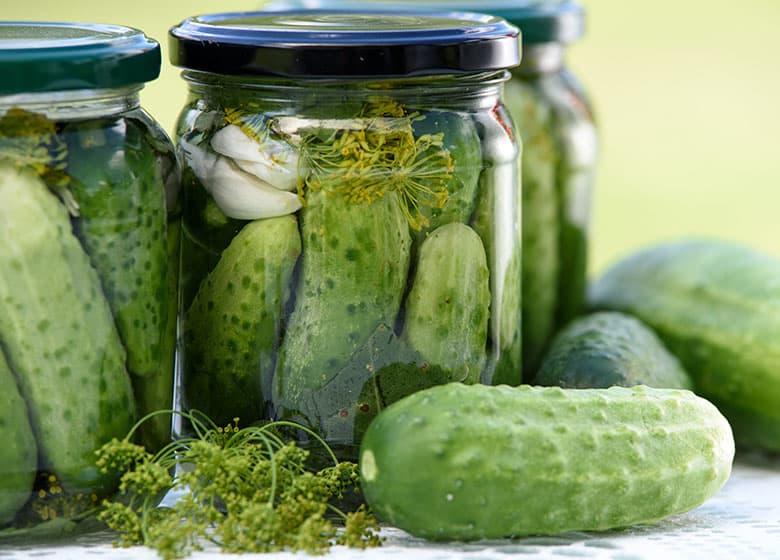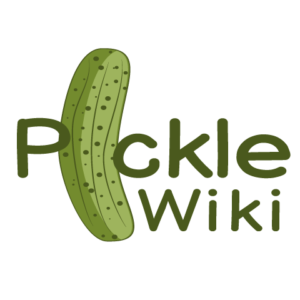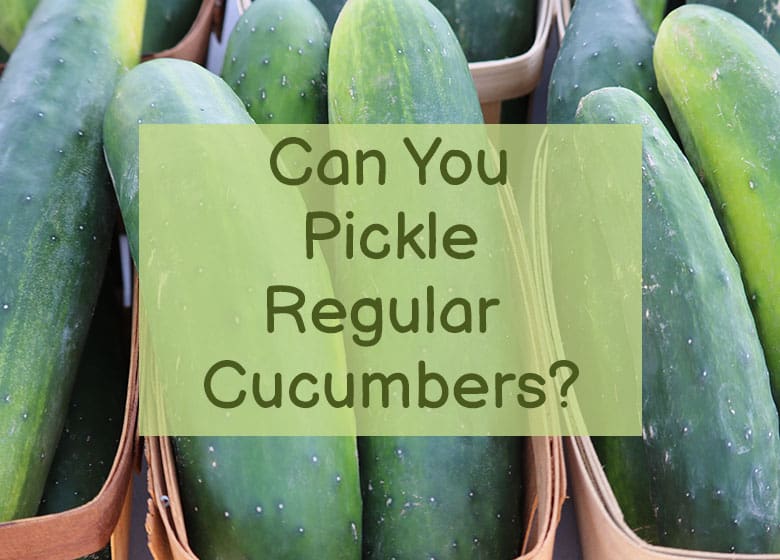One of the most common foods preserved is pickles. They are delicious and can last for years. However, some people try to avoid pickles because they feel like they require certain cucumbers that they just cannot find often at the market.
Garden cucumbers are the most common cucumber you will find in the grocery store. They are thin-skinned and contain a higher water content than pickling cucumbers. You can still make pickles with regular cucumbers if you and slice them.
I will explain how to make pickles from various cucumbers. This article will explain the results of pickling regular cucumbers and how their tastes and textures will differ from traditional jarred pickles.
Making Pickles from Regular Cucumbers
When we say “regular cucumbers” these are referred to as “slicers”. Slicing cucumbers tend to contain more water than pickling cucumbers. Therefore, they are not as crisp as pickling cucumbers. Instead, they are fleshy and thin-skinned, this can somewhat affect their ability to absorb flavor from the brine and makes them naturally not as crunchy.
Slicing cucumbers are very common in grocery stores and they can even have waxed skins that can prevent the absorption of brine.
When you pickle a slicing cucumber, they tend to be soft and juicy. But they can also be used to make relish if you do not care about the crispness of the pickles.
eeling slicing cucumbers can allow for better absorption of the brine and make the pickles more flavorful as well as remove any waxy coating that these cucumbers may or may not have.

Making Burpless Cucumber Pickles
Burpless cucumbers are sweeter than other cucumbers and have thinner skins. This can produce a rich flavor. Despite the thin skin, burpless cucumber skins are tough. Therefore, brining may be difficult.
Much like slicing cucumbers, burpless cucumbers can turn into soft and juicy pickles.
Pickling Cucumbers Make the Best Traditional Jarred Pickles
Pickling cucumbers tend to be dry and absorb more of the brine. Furthermore, pickling cucumbers have crisp skins and flesh that many people like in their pickles. These cucumbers are very flavorful even though their pickling can significantly change their flavor.
There are many types of pickling cucumbers including:
- Boston pickling cucumbers – These are seedless with great crispness and flavor.
- National pickling cucumbers – These cucumbers have especially thick skin and are especially crisp.
- The bush pickle – These cucumbers are smooth and very sweet.
Fresh Pack Pickles Can Use Various Cucumbers
Normally, pickles take more than a week to brine in a jar. When you jar pickles, you should try to pickle pickling cucumbers for a longer time to establish a full flavor.
While slicing and burpless cucumbers are not the best cucumbers to make traditional jarred pickles with, they can be used in fresh pack pickles.
Fresh pack pickles are minimally processed vegetables that are brined for a minimum of a day to produce the flavor desired. They could be compared to a slaw or a salad. When prepared properly, they can be a great addition to many dishes. However, people do tend to use slicing and burpless cucumbers more for these types of pickles because slicing and burpless cucumbers keep more of their taste than pickling cucumbers.
Essentially, when you use a pickling cucumber, you should expect much of the flavor to come from the brine. Little flavor will come from the pickling cucumber itself. When you use a regular slicing cucumber or even a burpless cucumber, you should expect the brine flavor to couple with the cucumber flavor. Some of the flavor from these cucumbers will stay even after a long pickling session.
How To Make The Best Jarred Pickles

Many people have different ways to make pickles. If you want to produce crunchy pickles you should definitely use pickling cucumbers. There is no advice to make slicing cucumbers nor burpless cucumbers as crisp as a pickling cucumber. If you want crunchy pickles some of the general advice given includes:
- Jar cucumbers as quickly as possible – If you do not grow nor pick your own cucumbers this may be difficult. Even pickling cucumbers will not make crisp pickles if they have been picked weeks before you attempt to pickle them. They may even lose that edge in as little as a few days. Sometimes the fresher pickling cucumbers at farmers’ markets can provide good results, but if you want the crispest pickles ever, you need to grow them.
- Soak cucumbers in an ice bath before brining – Cooling the cucumbers will make them firmer and the pickles should be crisp after brining.
- Add calcium chloride or tannins to the jar – Calcium chloride can be used to crisp up pickles. If you want a more natural way to crisp up pickles, you can also use tannins. There are many tannin-containing plants used to crisp up pickles. These include:
- Grapes leaves
- Oak leaves
- Raspberry leaves
- Bay leaves
- Tea leaves.
How To Make Flavorful Pickles
Some rich flavors could be produced from a rich brine or vinegar when pickling. However, you can produce a variety of flavors using:
- Spices
- Juices
- Fruits
The flavors you can incorporate into pickling cucumbers are only limited by your imagination.
The key to making the best pickles is herbs and spices. Even if you have flavorful vinegar brining the pickles, you will end up with bland pickles. Some of the spices and their flavors include:
- Salt – The center of a pickle’s flavor. It also helps to remove moisture from the cucumber.
- Sugar – Used for sweet pickles including bread and butter pickles, but also counter-balances the tart flavor of the salts.
- Turmeric – Adds an earthiness to pickles and a great natural color to the pickles.
- Garlic and Onion – Adds aromatic flavors.
- Chili Peppers and Peppercorns – Add some sour and fruity notes as well as heat and spice.
- Dill Seed – Produces the signature taste of dill pickles.
Safety Issues with Pickling
Pickling is a fairly simple process, and you can produce richly flavored pickles with ease. One of the reasons for the flavor is the fermentation and the formation of bacteria including lactic bacteria. However, depending on their pH, pickles and their brine also make a great media for deadly bacteria including Clostridium botulinum. These bacteria can grow on pickles if their brine is not prepared properly.
The key to avoiding the growth of these deadly diseases is to control the acid content of your brine. When you are pickling cucumbers you may want to stick with the exact ratios of vinegar, water, sugar, and maybe even the salt. If the pH is off too much, you could end up in (and with) a deadly pickle.
Concluding Thoughts
Pickling cucumbers earned their namesake. They are used primarily for pickling whole. Their dryness and absorption make them perfect for brining and pickling.
However, that does not mean slicing and burpless pickles cannot be used to make pickles. They just form a different texture, and the brine could have different effects on the cucumbers.
You could jar these cucumbers to pickle them, but they would probably be better as a relish or as fresh pack pickles. These do not have the same crispness as pickling cucumbers, but they can add different flavors and feels in certain dishes that traditionally jarred pickles cannot. The brine helps enhance the flavor found in these cucumbers instead of replacing them.
You are free to try to produce your own flavor when it comes to pickles, especially in the cucumber you use. When you do this, do it while noting that the process of pickling is a form of fermentation which involves control of microorganisms that may or may not cause disease depending on their environment while in a jar.

